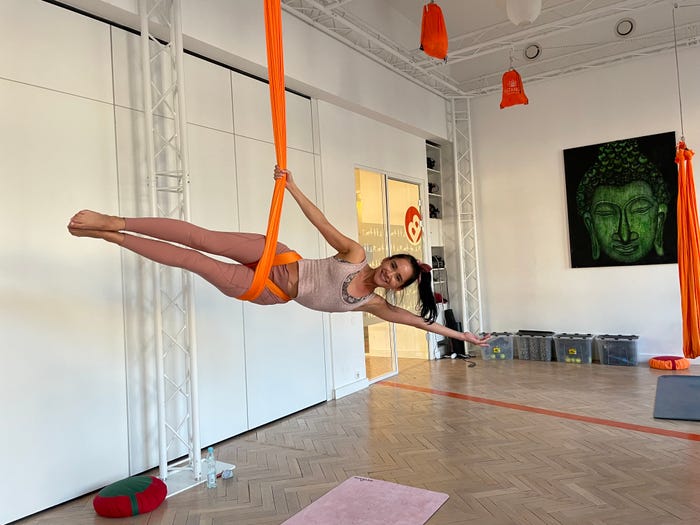I love taking yoga classes in a foreign language when I travel alone. Here’s why.
4 min readI love taking yoga classes in a foreign language when I travel alone. Here’s why.

Courtesy of Sonya Matejko
- When I moved to Europe in 2021, I took yoga classes taught in different areas’ native tongues.
- I’m a yoga teacher, and it forced me to approach yoga in a new way and recognize my body’s limits.
- By taking classes abroad, I could explore different studios and immerse myself in local cultures.
I’m an English-speaking yoga teacher, and I find there’s nothing quite like being in a dark, candlelit yoga class in Paris and hearing the teacher say, “sens ton coeur,” or “feel your heart.”
I don’t speak French — despite taking it for two years in college — but I do find the language incredibly beautiful, like the magic of twinkling holiday lights put into words.
Courtesy of Sonya Matejko
Since moving to Europe alone in 2021, I’ve taken yoga classes in French, Italian, Portuguese, Flemish, German, and Polish. (The French experience was my favorite.) When I travel, I do my best to make time for yoga and seek out local studios that teach in their native tongue versus English-speaking ones.
By attending yoga classes in languages I don’t understand, I’ve learned much about myself, my practice, and my teaching style because I get outside my comfort zone.
As a teacher, I’ve learned the value of nonverbal cues
When I don’t understand the words coming out of the teacher’s mouth, I look at their hands.
People who speak all different languages use hand gestures and naturally incorporate them into their yoga teaching. As a teacher, I’ve learned from these experiences that simple hand gestures can hold as much power (if not more) than a demo of a pose.
Whether a teacher is highlighting a body part, indicating to rise, or mimicking how to twist and turn, their hands speak a language of their own, and it’s something I’ve tried to incorporate into my teachings.
There’s also value in voice intonation, emphasis, and volume. You can make an educated guess on what the teacher is guiding you to do by focusing on how something is said. Most teachers naturally do this to signify relaxation or power so students know the intention behind the pose.
Courtesy of Sonya Matejko
As a student, I’ve gained greater bodily awareness
Instead of trying to translate what a teacher is saying when in a pose, I focus on translating what my body is telling me. While I assume the teacher is offering guidance on how to position or go deeper into a pose, I turn inward to see how I need to adjust to feel more grounded in the position.
Doing so has helped me tune into what feels good, rather than just follow instructions. That increases my self-awareness. Though I can glean some of the instructions by watching the teacher or listening to their tone, at times I can’t get all the directions this way, so I take the opportunity to see what path my body wants to take me, and that has felt incredibly liberating and clarifying.
This lesson has also helped me determine my limits in yoga. In other words, it takes my ego out of the equation when I don’t know the language. I can figure out whether I want to be softer on myself when my body is tight. If it is, I will avoid going deeper into a pose and stay still more often. This has also saved my shoulders and lower back, as I usually skip doing a lot of Chaturangas.
Courtesy of Sonya Matejko
As a yoga lover, I’ve learned it’s a unifying practice
When teachers use the original Sanskrit words in class, I appreciate it even more. Sanskrit is the original language of yoga and the root of many Indian languages. There are many warranted arguments made about the Westernization of yoga, and I enjoy hearing the root terms that the ancient practice was based upon. Whether you take yoga in Spain or Belgium, hearing a Sanskrit word or phrase (such as “adho mukha svanasana,” aka downward-facing dog) sparks a note of recognition of yoga’s origin.
Taking a yoga class in a language you’re not fluent in can be an equalizer; in doing so, you become somewhat of a beginner again, even if you’re a teacher, because you have to approach the practice differently and learn a new set of awareness tools.
Going to a yoga class in another language also gives you a taste of the local community. I love hearing new languages, exploring different studios, seeing how differently students interact. It allows me to feel momentarily immersed in a local community.
Courtesy of Sonya Matejko



